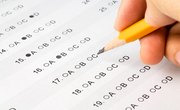In the modern climate of high-stakes testing and educational accountability, the success of a school is measured by the school's achievement of set performance indicators. These indicators are intended to demonstrate how effectively the school is preparing pupils to perform in the real world. While specific regulations vary from state to state, in many areas, schools are graded upon whether or not they meet these pre-set indicators and, in some instances, funding decisions are made based upon the proven success of the educational institution.
Standardized Test Performance
The most commonly used performance indicator is standardized test results. Standardized tests are intended to measure student comprehension in relation to other pupils in the same academic year. In theory, schools that are effective will produce students who score proficient on standardized tests. Most states monitor individual school building as well as school district standardized test scores and look for trends in test passing or failing. In some schools, these scores are tied to job retention or bonus granting. Many teachers argue against the validity of standardized test scores, insisting that these tests are not a true measure of the complete academic knowledge of student test takers and, as such, should not be seen as the only measure of educational success or failure.
Attendance Rate
Many states consider attendance rates when determining a schools educational effectiveness. The impetus behind considering attendance rates is the idea that students can not learn when they are not in school and, therefore, schools should go to great lengths to ensure that their pupils spend as much time in the classroom as possible. States that consider attendance rates as a performance indicator set a standard attendance rate and declare any school building that achieves that minimum attendance rate a successful school in relation to that indicator.
Graduation Rate
When considering the effectiveness of a high school program, graduation rate is commonly used as a performance indicator. The ultimate goal of a high school program is to reward students with a diploma to indicate their mastery of high school academic concepts. Schools often work to ensure that students resist the urge to drop out. As with attendance rate, many states set a standardized graduation rate and declare any school that achieves this rate as successful. Graduation rate is not considered in elementary and middle schools as neither of these lower-level schools have an official graduation.
Achievement of Adequate Yearly Progress
Under the No Child Left Behind Act, all schools should be working towards attaining 100 percent proficiency. This act dictates that each year schools should move closer and closer to this lofty goal. Schools that make what is deemed adequate progress towards this goal each year are seen as making Adequate Yearly Progress or AYP. Under the Safe Harbor provision of this bill, schools that do not achieve the set progress percentage can still be seen as meeting AYP by improving their students' test scores a set percentage. Schools often work hard to ensure that they are working towards AYP, as failure to do so can result in the closing of a school building due to ineffectiveness.
Related Articles
References
Writer Bio
Erin Schreiner is a freelance writer and teacher who holds a bachelor's degree from Bowling Green State University. She has been actively freelancing since 2008. Schreiner previously worked for a London-based freelance firm. Her work appears on eHow, Trails.com and RedEnvelope. She currently teaches writing to middle school students in Ohio and works on her writing craft regularly.











